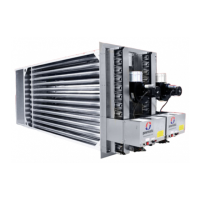1.3.1. Related Documents
The installation of the module(s) must be in accordance
with the rules in force and the relevant requirements of the
Gas Safety Regulations, Building Regulations and the I.E.E.
Regulations for Electrical Installations. It should also be in
accordance with any relevant requirements of the local gas
region, local authority and re authority and the relevant
recommendations of the following documents.
Institution of Gas Engineers & Managers
IGE/UP/1 (Ed.2) Strength and tightness testing and
purging of industrial and commercial gas installations.
IGE/UP/1A Soundness testing and direct purging of small
low pressure industrial and commercial gas installations.
IGE/UP/2 Gas installation pipe work, boosters and
compressors on industrial and commercial premises.
IGE/UP/10 (with Amendments October 2010) Installation
gas appliances in industrial and commercial premises.
British Standards Code of Practice
BS 5588 Fire precautions in the design and construction of
buildings.
Part 2 : 1985 Code of Practice for Shops
Part 3 : 1983 Code of Practice for Oce Buildings
BS 6230 Installation of Gas Fired Forced Convection Air
Heaters for Commercial and Industrial Space Heating.
Those appliances having a gross input rating not exceeding
60kW and installed to take their combustion air from
within the building must be installed in accordance with
the relevant recommendations of the following document.
BS 5440 Flues and Air Supply for gas appliances of rated
input not exceeding 60kW (1st and 2nd family gases), Part
2 – Air Supply
BS 5864 Code of Practice for installation of gas-red
ducted-air heaters of rated input not exceeding 60kW.
Electromagnetic Compatibility (EMC)
These heaters pass the following standards for
Electromagnetic Compatibility: EN 61000-6-3:2007 A1
(Generic Emissions for Residential, Commercial and Light
Industrial Environments) and EN 61000-6-2:2005 (Generic
Immunity for Industrial Environments).
1.3.2 Electrical Supply
Wiring external to the air heater must be installed in
accordance with the I.E.E. Regulations for Electrical
Installations and any local regulations which apply.
All modules are supplied by 230V - 1ph, 50Hz. The method
of connection to the main electricity supply must:-
- facilitate the complete electrical isolation of the unit(s)
- be in a readily accessible position adjacent to the unit(s)
- serve only the unit(s)
- have a contact separation of at least 3mm in all poles.
See the accompanying wiring diagram for the heater
electrical connections
1.3.3 Gas Supply
A servicing valve and union to facilitate servicing must
be tted to the gas inlet pipe work of the heater. The gas
supply must be completed in solid pipe work and be
adequately supported.
Warning
When completing the nal gas connection
to the heater do not place undue strain on
the gas pipe work of the heater.
1.3.3.1 Service Pipes
The local gas undertaking should be consulted at the
installation planning stage in order to establish the
availability of an adequate supply of gas. An existing
service pipe must not be used without prior consultation
with the local gas undertaking. The inlet gas pressure
under running conditions must not be less than 20.0mb.
1.3.3.2 Meters
An existing meter should be checked, preferably by the gas
undertaking, to ensure that the meter is adequate to deal
with the total rate of gas supply required by all connected
equipment.
1.3.3.3. Installation Pipes
Installation pipes should be tted in accordance with IGE/
UP/2. Pipe work from the meter to the air heater must be
of adequate size. Do not use pipes of a smaller size than
the inlet gas connection of the heater. The complete
installation must be tested for soundness as described in
the above Code.
1.3 General Requirements

